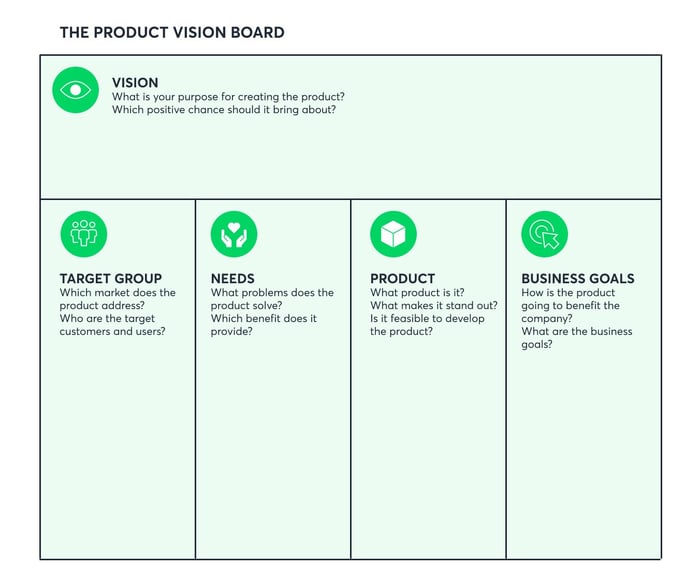The Product Vision Board: Describe Your Product Vision and Strategy

You will discover how vision board tools help to improve communication, to maintain transparency and help team members to clarify their goals and tasks, and ultimately, to help your business to succeed.
You will learn useful product vision and strategy examples, and you will also learn how using an agile vision board is advantageous within the product management process.
What is a product vision board?
The Product Vision Board is a product planning and strategy tool (or product vision canvas) that can helpproduct managers, the product development team, product stakeholders, and company owners to map out the motivations for creating a product, the reasons why the product should be created, the customer demographics, the goals that you wish to achieve through the release of the new product, and more.
What sections does the vision board include?
The vision board is a new tool that is split into five different sections.
Vision
Will include a brief vision statement, where you establish: what you aim to achieve with the product, what problems your product is helping to solve, what the motivation is for launching the product, how it will change the market, who it is intended for, why it is the right time to build the product etc.
It also helps to highlight any gaps in the market (problems that customers might be experiencing that can be solved with the introduction of this product), the positive impact that this product could bring by being introduced to the market etc.
Having a product vision helps your team to achieve a bigger picture in terms of understanding what they are working on, and why.
Target Group
Will include your demographic (also known as market segment or target group). Here you will outline who your product is aimed at. This section may include age, whether you need to enter a new market, the target group you are aiming to reach, which segments of the market you are trying to market to etc.
Needs
Will include solutions that this product will solve. By introducing this product to the market, does it tackle the problems customers are facing? Which problems does it solve? What are the benefits for customers by introducing this product?
Product
It’s all about your product. What makes your product different from your competitor’s product? Is it possible to create this product right now? Do you have the visioning tools you need to make your product a reality? Is it feasible to develop this product right now? (with the resources available).
Business Goals
Will include your business goals section, or your overarching objective that you aim to achieve with this product. The information included here will be tied with your initial vision for the product.
How does the product benefit your business? Will this product help the business to achieve its many goals? You should outline your overall business goals here and see if you can match them to this product (i.e. by releasing this product, will it help your business to achieve its goals?).
When should you use it?
You should use the goal board template in the initial stages of the product development process. It should be aproduct management tool that you use to identify and highlight ideas upon, and refer back to at all stages within the process.
Product boards should be a ‘go-to’ at all times. The product vision board essentially evolves along with the creation of a product, so it will likely be subject to change as you continue to create your ideal product.
How can you benefit from the product vision board?
There are many ways you can benefit from the use of a product vision board. For instance, by continually referring back to it, you can help to regain focus and measure how close you are from achieving your goals.
The product vision board helps you to understand the greatest risks involved with creating your product, as well as helping to establish the opportunities that could be realised through releasing it.
As with any form of planning tool, the vision board will always be useful. You could potentially reuse it for other similar products and tweak it where necessary, in order to reflect the major differences between the products.
The product vision board helps teams to maintain a common understanding, it improves overall communication between team members, and it guides everyone involved with the development of the product.
Everyone involved in product management, development marketing, sales, support, and the various other stakeholders involved in the process will benefit from the usage of this tool.
Moreover, the vision board is ideal for assisting teams with the facilitation of product pitching/idea pitching, as well as helping to maintain transparency in the overall product management process. It also helps team members to effectively align their goals and responsibilities with others.
What are the disadvantages of using the product vision board?
The product vision board is not a perfect tool, because all types of business tools have flaws. Perhaps the biggest disadvantage of the product vision board is its attempt to simplify a complex process.
Sure, you can make your product development process more agile, but you cannot escape external factors that are out of your control, and how they can impact the development of your product.
For instance, if you cannot successfully source the materials you need from your suppliers in order to create your product, you might be forced to compromise by having to use cheaper, lower-quality materials.
By doing so, you will not be creating the product you had initially envisioned, and therefore, you will not be able to achieve all of the business goals you had hoped to achieve by making use of the vision board in the development process.
Product vision board template
Roman Pichler has created a clear and concise product vision document template that’s easy to understand, and will help you to accurately plan out your goals for your product, as well as to map out your product strategy. This template will help you achieve clear vision in your planning.

Source: romanpichler
Roman’s website has a bunch of useful resources, including a video where he breaks down the product vision template in powerpoint.
Tips for creating your product vision board
- Create an uplifting and motivating product vision to make sure that your team maintains high morale, with constant motivation. For instance, Tesla’s achievement of creating the most compelling car company of the 21st century, by driving the world's transition to the use of electric vehicles.
- Don’t mix product vision and product strategy, keep them separated. Product vision is not a plan that demonstrates how to reach your goals, this is a product strategy.
- Employ a shared vision through working together and aiming to achieve team alignment in your goals and approach. Make sure to share the product vision board with stakeholders and ensure it is properly facilitated and updated throughout the development process.
- Product vision should keep the team motivated and inspired, so don’t choose a limited vision. Think big, and always make sure that you maintain high ambition, but don’t lose focus. Product vision in essence should be short and essential, easy to understand and shareable. Keep it simple and minimalistic.
- Choose your target group wisely. It should not be too big or too small, if the group is large and heterogeneous, segment it into homogeneous groups.
- Focus on the main triggers/reasons for users in terms of why they should use your product.
- Address needs with features, and not the opposite direction.
- Be specific in the process.
It’s clear that by projecting your ideas onto a blank vision board you can fill it with your vision and strategy, a brief statement explaining the key features of your product idea, the desired business benefits of releasing the product into a new market or an existing one, and the unique selling proposition, all within one clear space.
Effectively capture your product vision and strategy
It’s an invaluable tool for product development teams, because it helps them to truly visualize their vision for a product and make a meaningful positive change in the overall process, as well as map out all of the stages necessary in making that vision a reality. It will help you to fully understand the big picture, and then turn that understanding into a product that customers will love.



...%20hero.jpg?width=1200&height=630&name=Jetpack%20Compose%20vs%20Flutter%20(With%20Examples)...%20hero.jpg)



